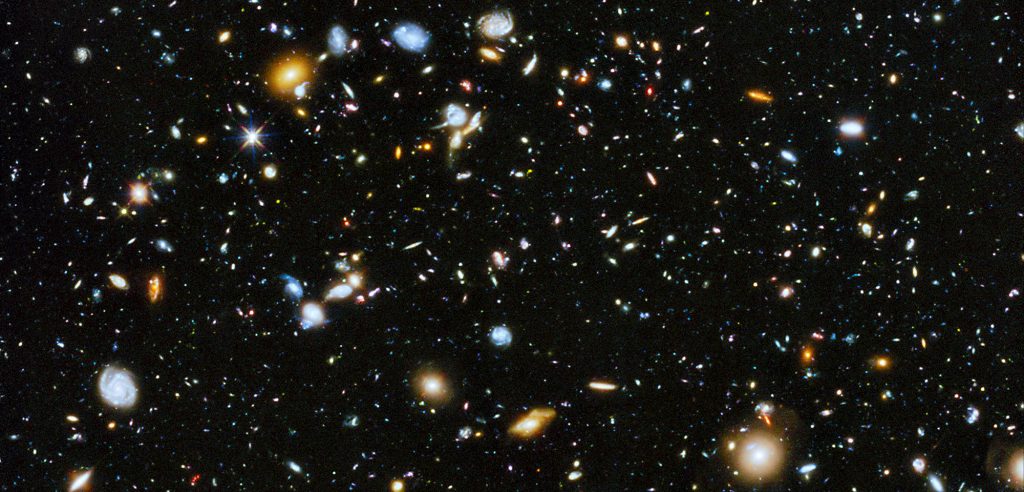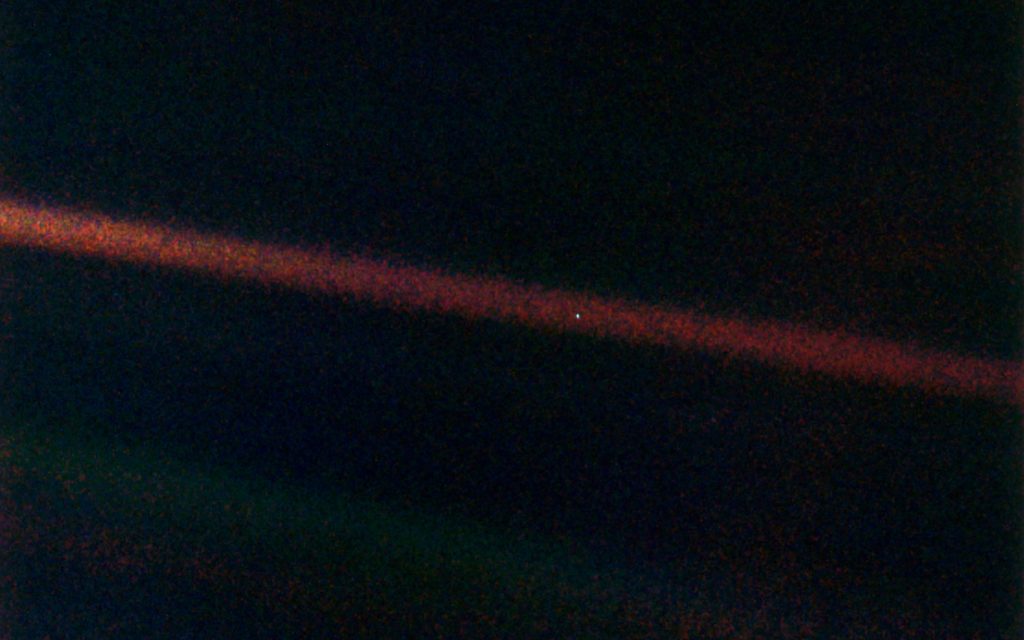
No one knows the full extent of the size of the universe we inhabit because we can’t see it all, and we never will. In the part we can observe, there are at least two trillion galaxies, which contain many more stars than there are grains of sand on the Earth.
Many of these stars may have a solar system of planets, so there might be as many or more planets than there are stars. Earth is just one of these planets in one of these solar systems in one of these two trillion galaxies in the observable universe.
It is hard to contemplate the magnitude of what I’m trying to say….
What we can see in all directions is rather BIG. There are other planets in our solar system that are bigger than our planet, the sun is much bigger than any of the planets in our solar system, and there are plenty of other suns that are much bigger than our sun. And there are bigger things than stars. And there are all those massive Black Holes in the centers of most galaxies and sprinkled throughout them.
We used to believe that all of reality turned about us, that we were the center of the universe, that it was ALL ABOUT US. We used to think that the Sun revolved around the Earth, then we found it was the other way around. We used to think that stars were just small celestial spheres in the dome of heaven above us, now we know that our solar-system is just one of perhaps tens of billions of solar systems in the Milky Way (maybe as many as 100 billion). We used to think our galaxy was the whole universe, now we know that there are so many other galaxies that if ours disappeared, no one might notice (and maybe there would be no one to notice). We used to believe that ours was the only universe, now some think that there might be an infinite number of universes.
On the Grand Scale of Things, our Earth may be much, much tinier in relationship to the universe (or multiverse) than a subatomic particle is in relationship to us.
In 1977, NASA launched the space probes Voyager 1 and Voyager 2 on a Grand Tour to the planets in our outer Solar System. In 1990 when Voyager 1 was approximately 6 billion kilometers or 3.7 billion miles away and had completed its primary mission, astronomer and science popularizer Carl Sagan convinced NASA to turn around its camera and take one last photograph of Earth. The resulting image of Earth took up less than one pixel (0.12 pixels) in the 640,000 pixel photograph.

Here is what Sagan had to say about it later in some of the best lines ever spoken by anyone….
Look again at that dot. That’s here. That’s home. That’s us. On it everyone you love, everyone you know, everyone you ever heard of, every human being who ever was, lived out their lives. The aggregate of our joy and suffering, thousands of confident religions, ideologies, and economic doctrines, every hunter and forager, every hero and coward, every creator and destroyer of civilization, every king and peasant, every young couple in love, every mother and father, hopeful child, inventor and explorer, every teacher of morals, every corrupt politician, every “superstar,” every “supreme leader,” every saint and sinner in the history of our species lived there–on a mote of dust suspended in a sunbeam.
The Earth is a very small stage in a vast cosmic arena. Think of the rivers of blood spilled by all those generals and emperors so that, in glory and triumph, they could become the momentary masters of a fraction of a dot. Think of the endless cruelties visited by the inhabitants of one corner of this pixel on the scarcely distinguishable inhabitants of some other corner, how frequent their misunderstandings, how eager they are to kill one another, how fervent their hatreds.
Our posturings, our imagined self-importance, the delusion that we have some privileged position in the Universe, are challenged by this point of pale light. Our planet is a lonely speck in the great enveloping cosmic dark. In our obscurity, in all this vastness, there is no hint that help will come from elsewhere to save us from ourselves.
The Earth is the only world known so far to harbor life. There is nowhere else, at least in the near future, to which our species could migrate. Visit, yes. Settle, not yet. Like it or not, for the moment the Earth is where we make our stand.
It has been said that astronomy is a humbling and character-building experience. There is perhaps no better demonstration of the folly of human conceits than this distant image of our tiny world. To me, it underscores our responsibility to deal more kindly with one another, and to preserve and cherish the pale blue dot, the only home we’ve ever known.
Launched in 1977 and traveling at 17 kilometers per second (11 mi/s), it wasn’t until August 25, 2012 that Voyager 1 became the first spacecraft to cross the boundary between our sun’s solar wind and the rest of the galaxy and enter interstellar space. In about 40,000 years it may pass within 1.6 light-years of the star Gliese 445, which is racing towards our Solar System at 119 km/s (430,000 km/h; 270,000 mph).
However big many objects in the observable universe may be in relationship to us, they all pale in relationship to the size of the observable universe itself. Despite the fact that the number of stars we may see are possibly 10 times more numerous than all the grains of sand on Earth, they are very far apart from each other.
Our own Milky Way galaxy contains between 200 and 400 billion stars, and the distance between the local stars in our galaxy is proportional to two grains of sand more than 30 miles apart.
Proxima Centauri is the closest star to us after the sun is about 4.24 light years away. If Voyager 1 was headed in that direction (which it isn’t), it would take 76,000 years to make it there. Using some kind of Gravity Assist method like Helios 2 did to get a slingshot effect from the Sun (setting the record for the fastest man-made object ever at over 240,000 km/hr or 150,000 miles/hr), it would take about 19,000 years.
Some proposed technically feasible faster methods include the Radio Frequency (RF) Resonant Cavity Thruster (or EM Drive), which would reduce the travel time to 13,000 years, and the Nuclear Thermal and Nuclear Electric Propulsion methods which might cut it down to a mere 1,000 years.
Proposals for more theoretical methods like Nuclear Pulse Propulsion, Fusion Rockets, Fusion Ramjets, and so on could cut the travel time down to a few dozen years but are problematic for many reasons and aren’t very economically feasible. A Laser Sail method could get us there in a dozen years or so, but it would take a steady flow of all the power consumed on Earth every day and a sail hundreds of miles in diameter. Using some kind of Antimatter Engine could cut the time down to as little as 8 years, but it would require hundreds of thousands (maybe millions) of metric tons of antimatter fuel, but it currently costs over a trillion dollars to produce just one gram of antimatter, and the total amount we’ve ever created is less than 20 nanograms (this is not counting the tremendous size and cost of the ship and many other technological hurdles that would have to be overcome).
Even if we could travel at or very near to the speed of light, it would still take 4.24 years or more just to reach the nearest star beyond our sun. And traveling at or close to the speed of light may not even be possible. As you approach the speed of light, whatever spaceship you’re traveling in becomes increasingly more massive requiring more energy until the amount of energy required approaches infinity. The speed of light is the cosmic speed-limit because reaching it may require an infinite amount of energy.
Of course, the most theoretical proposed method is some kind of “Warp Drive,” where you would ride in a kind of “warp bubble” that stretches out the fabric of space-time into a wave to cause the space ahead to contract and the space behind to expand. You wouldn’t be violating the speed of light cosmic speed limit because you wouldn’t actually be moving through space. You would be resting in a bubble that would be warping the space around it. This method could cut the travel time to less than 4 years, but it may not be actually possible. It may require a prohibitive amount of energy to work, and we may find that it violates one or more of the fundamental laws of nature.
Our Milky Way galaxy is 100,000 light years in diameter (tiny compared to the galaxy M87 at 980,000 light years in diameter or the galaxy Hercules A, which is 1.5 million light years across). If Voyager 1 were headed to the center of our galaxy (which it isn’t), it would take more than 450,000,000 years to make the trip. Even if it could travel at the speed of light, it would take over 26,000 years.
The two trillion galaxies in our observable universe are separated from each other by even greater distances than local stars are within these galaxies.
The Milky Way has some smaller satellite galaxies around it, but the nearest major galaxy to the Milky Way is Andromeda, 2.5 million light-years away. Even with some kind of light-speed rocket or Warp Drive, ever making a trip like that may forever be beyond us.
The Andromeda Galaxy is estimated to collide with the Milky Way Galaxy in about 4.5 billion years, so it may be easier to wait for it to come to us. But aside from galaxies which are gravitationally drawn to each other in local groups like Andromeda and the Milky Way are in ours, the universe is getting bigger all the time due to Dark Energy at an ever increasing rate. The 2.5 million light-years from the Milky Way to Andromeda is a short hop compared to the size of the observable universe which has an estimated diameter of 93 billion light years and a radius of about 46.5 billion light years. And the universe is getting bigger and bigger at an exponential rate all the time.
As Douglas Adams said in The Hitchhiker’s Guide to the Galaxy, “Space is big. Really big. You just won’t believe how vastly hugely mind-bogglingly big it is.”